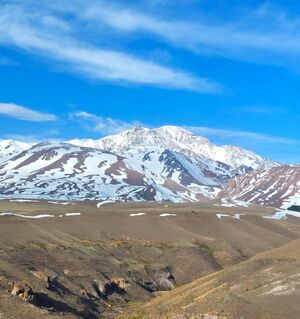Prostasian Mountains (Pacifica)
Parts of this article (those related to Template) need to be updated. The reason given is: Infobox data needed you'll have to add it yourself. (May 2024) |
| Prostasian Mountains | |
|---|---|
| Prostasia, Prostasia Range | |
 Mount Mirena with the surrounding Prostasian Mountains from the Alla-gyan side in June 2024. | |
| Highest point | |
| Peak | Mount Mirena, Rhayna |
| Elevation | 4,719 m (15,482 ft) |
| Dimensions | |
| Length | 2,275 km (1,414 mi) |
| Geography | |
The Prostasian Mountains, often called simply Prostasia or Prostasia Range, are a mountain range in southwestern to northwestern Moellia. The term "Prostasian" comes from the word Prostasia (Aegean: Προστασία, Aegean pronunciation: [pɾ̠o̞st̪ɐsiɐ]). The general definition used is one followed by the Rhaynan Geographic and Topological Organization (RGTO) to describe the respective country's physiographic regions. The UPRAN uses the term "Προστασική οροσειρά" (Prostasian Mountain Range).
The Prostasia Range runs from the Roillo Fault in Qaweritoyu down the frontier between Rhayna and Yttria; south through Moellia, separating Rhayna and Alla-gy; and finally southwest wards along the frontier between UPRAN and Hystaiga. The highest peak of the mountain range is Mount Mirena in eastern Ephios at 4,719 metres (15,482 ft), which is also the highest point in Rhayna and UPRAN.
The range is younger than the other major mountain range in Moellia, the Defteran Range of the east. Some of the outcrops in Prostasia contain rocks formed as far back as the start of the Eocene. The geologic processes that led to the formation of Prostasia started [Placeholder] years ago. The mountain range was created when the continent of Cordilia and the Eastern Pacific Plate collided, subducting the oceanic plate and lifting the range. The collision of these plates caused the material to heat up and break through the crust, creating the first volcanoes in the region. Many of the first rocks and minerals that were formed during that event are buried below hundreds of meters of volcanic soil nowadays. However, these processes started slowing down around 6 million years at the end of the Miocene, with major volcanic activity becoming less prevalent 2220 years ago, around the time at which Mount Mirena and Mount Cigela became inactive. Since the processes that formed Prostasia ended recently or just slowed, the mountain range hasn't suffered much of the effect of erosion and still conserves most of its original height.
The Prostasian Mountains, to a higher degree than Defteros, are a barrier to west–east travel, as they constitute some of the highest peaks of the region oriented in opposition to most highways and railroads running eastwards. This barrier was extremely important in shaping throughout history and prehistory the interactions between the population of Rhayna and Alla-gy, and isolating the Rhaynan desert from all other populations outside Moellia.
Prostasia is home of a variety of touristic and domestic activities in UPRAN, such as skiing, trail hiking and volcanic tourism. It also hosts multiple astronomic observatories and meteorological centres, since the region is barely populated.